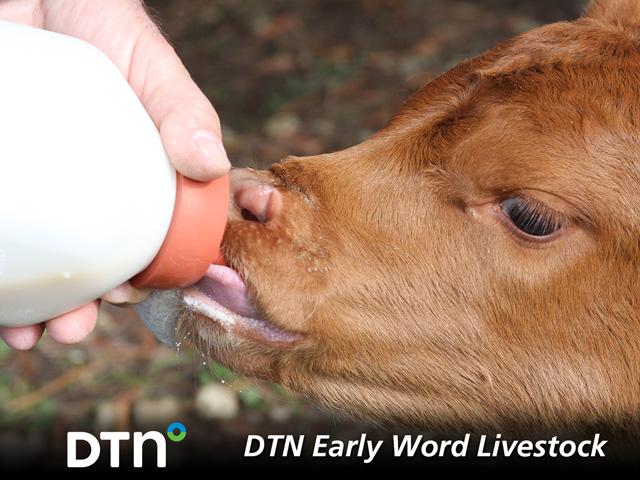DTN Early Word Livestock Comments
German African Swine Fever Case Changes Market Direction
Cattle: Steady w/Early Week Trade Futures: Higher Live Equiv $143.59 -0.89
Hogs: Higher Futures: Higher Lean Equiv $ 86.37 +0.73**
* based on formula estimating live cattle equivalent of gross packer revenue
** based on formula estimating lean hog equivalent of gross packer revenue
General Comments:
Following moderate trade in all areas on Tuesday and Wednesday at lower money, both sides appear willing to wait until sometime Friday before trading additional cattle. Given the active cattle sales over the last several weeks, it is expected that at least some additional movement will be seen before the end of the day. Although feeders are looking for higher prices based on the underlying support moving into the futures trade. Trade at $101 per cwt live in the South and $160 dressed in the North seems to be the base price levels seen earlier in the week, which at the end of the day, may gain additional trade if feeders are not able to push prices higher before that point. Given the number of cattle already sold for the week, it is uncertain how trade Friday will shift the overall weekly average prices, which are expected to be $2 to $3 per cwt lower than last week. Expected strong follow-through support in lean hog futures is likely to add additional spillover support to live cattle and feeder cattle trade early Friday. Seasonal pressure in boxed beef values is still developing following Labor Day, but the focus on a dynamic shift in world supplies of pork will not only impact domestic and export pork values, but will quickly spill over to the beef complex and overall demand for beef. Feeder cattle futures have and are likely to continue to show significant market support despite the recent gains in corn prices. Higher corn prices add to production costs and typically pressure feeder cattle prices. But at this point, feed and production costs are being overlooked as traders focus on potential long-term beef market gains following additional market availability worldwide.
Limit gains in lean hog futures Thursday is expected to spark additional widespread support at the end of the week. The announcement Thursday that Germany confirmed the first case of African swine fever in a wild boar, and South Korea was the first country to ban pork imports from Germany is likely to spark additional reactions around the world. This is significant because Germany is the largest pork producer in Europe, and this move quickly puts U.S pork supplies in a spot to quickly expand export markets around the world. The short- and long-term implications of this change in the industry will be significant and is likely to add even more support to hog futures at the end of the week. Expanded trading limits of $4.50 per cwt are available in all hog contracts, with the potential that strong end-of-the-week gains will flood into the complex at opening bell. Cash hog prices are expected $1 lower to $2 higher with most bids expected steady to $1 higher. Slaughter Friday is expected at 481,000 head. Saturday runs are expected at 410,000 head.
| BULL SIDE | BEAR SIDE | ||
| 1) | Renewed buyer support in live cattle and feeder cattle trade following the upward surge in prices in lean hog futures is expected to focus on regaining fundamental buyer support, which could spark renewed long-term interest in all cattle futures. | 1) | Cash cattle prices continue to gain limited support despite support from futures markets and optimism that the gains in hog prices will add to short- and long-term demand growth for beef. Packers continue to gain access to market-ready cattle at lower prices, unwilling to push prices higher at the end of the week. |
| 2) | Feeder cattle futures have posted a strong "double bottom" at $138.25 per cwt in October futures, which has the potential to rekindle additional technical buyer support in the feeder cattle complex. This may very well signal the seasonal low in the complex as traders look for additional support in the fourth quarter of 2020. | 2) | Seasonal beef demand pressure is still the driving force through the live cattle complex during the first two weeks of September. With the majority of beef demand utilized domestically, significantly less impact to beef values will be seen from expanded pork exports. |
| 3) | African swine fever found in Germany's boarders has quickly changed the scope of world pork demand, as South Korea was the first country to ban German production. This opens the door for expanded U.S. pork exports over the near future and is likely to change the course of the lean hog market significantly. | 3) | Traders are focusing on the holiday-delayed release of weekly Export Sales reports and monthly WASDE numbers, both released Friday morning. This could quickly curb recent market optimism through nearby lean hog futures if active export numbers are not seen. |
| 4) | Expanded trading limits in lean hog futures will be available and are likely to see widespread gains as traders try to account for how worldwide pork markets will change following Thursday's ASF discovery. This is expected to further widen the skyrocketing lean hog futures price seen over the last two weeks. | 4) | The announcement of African swine fever in Germany brings a sobering reality that the U.S. industry is just "one potential case away" from a devastating blow to the domestic pork industry. This development in Europe makes it clear that AFS is not as much about the impact on production, but the availability to global markets. |
Rick Kment can be reached at rick.kment@dtn.com
(c) Copyright 2020 DTN, LLC. All rights reserved.
P[L1] D[0x0] M[300x250] OOP[F] ADUNIT[] T[]




